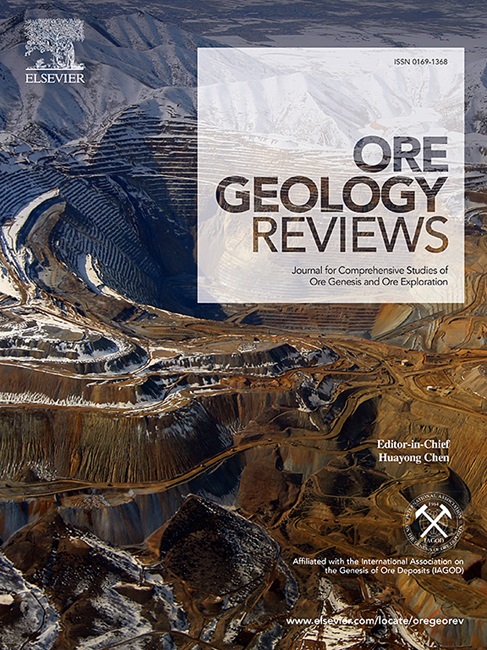Characterization of primary geochemical halos for the Hetaoba volcanic-related uranium deposits in Duolun County, Inner Mongolia
IF 3.2
2区 地球科学
Q1 GEOLOGY
引用次数: 0
Abstract
Primary geochemical halo is a powerful tool for exploring blind deposits. However, primary geochemical halo studies have seldom been conducted on hydrothermal uranium deposits. This study conducted primary geochemical halo studies on the Hetaoba volcanic-related uranium deposit in the Guyuan–Hongshanzi uranium-polymetallic metallogenic belt based on the 780 core samples with 20 elements analyzed from 13 boreholes. Staged factor analysis (SFA) of the centered log-ratio (CLR) transformed data showed that an ore-related elemental association is F1 (U–Mo–As–Pb–Cd–Sb association). However, scatter plots and anomaly maps based on the thresholds determined by the concentration–number (C–N) fractal model showed that the extent of sulfide-rich zones was larger than that of uranium mineralization, and some sulfide-rich zones were accompanied by low uranium content, although uranium mineralization was always accompanied by sulfide enrichment. Furthermore, uranium minerals were distributed along the metal sulfide edges and even encased them, suggesting that uranium mineralization may have occurred later than the sulfide precipitation. Zoning patterns of indicator elements (from top to bottom) for ore bodies at shallow (AZS1) and greater (AZS2) depths determined by Gregorian’s method are Bi–Zn–Cd–Mo–Sb–Cs–Pb–Hg–U–Sc–Be–Li–W–Cu–As–Tl–V–Co–Cr–Ni and Cr–Ni–Sc–Be–W–V–Co–Sb–As–Bi–Cu–Pb–Mo–U–Hg–Zn–Cd–Li–Tl–Cs, respectively. These results are significant for mineral exploration. Sulfide-rich zones may provide favorable space and reducing agents for uranium mineralization and can serve as an auxiliary indicator for uranium exploration. More importantly, strong Hg anomalies at relatively greater depths may represent favorable traps for uranium deposition. Consequently, Hg can serve as a near-ore indicator of uranium exploration at relatively greater depths. In addition, AZS2 front-halo elements may suggest the superposition of two metallogenetic stages and exploration potential in the up-dip of the fault zone.

内蒙古多伦县河桃坝火山型铀矿床原生地球化学晕特征
原生地球化学晕是寻找隐伏矿床的有力工具。然而,对热液铀矿床进行的原生地球化学晕研究很少。本文利用13个钻孔780个岩心样品,分析了20种元素,对古源—红山子铀多金属成矿带河桃坝火山型铀矿床进行了初步的地球化学晕研究。中心对数比(CLR)转换数据的阶段因子分析(SFA)表明,与矿石相关的元素关联为F1 (U-Mo-As-Pb-Cd-Sb关联)。然而,根据浓度-数(C-N)分形模型确定阈值的散点图和异常图显示,富硫化物带的程度大于铀矿化程度,尽管铀矿化总是伴随着硫化物富集,但部分富硫化物带却伴随着低铀含量。铀矿物沿金属硫化物边缘分布,甚至包裹在金属硫化物边缘,表明铀矿化可能发生在硫化物沉淀之后。用Gregorian方法测定的浅层(AZS1)和深部(AZS2)矿体指示元素从上到下的分带模式分别为Bi-Zn-Cd-Mo-Sb-Cs-Pb-Hg-U-Sc-Be-Li-W-Cu-As-Tl-V-Co-Cr-Ni和Cr-Ni-Sc-Be-W-V-Co-Sb-As-Bi-Cu-Pb-Mo-U-Hg-Zn-Cd-Li-Tl-Cs。这些结果对矿产勘查具有重要意义。富硫化物带为铀矿化提供了有利的空间和还原剂,可作为找矿的辅助标志。更重要的是,相对较深的强汞异常可能代表有利的铀沉积圈闭。因此,汞可以作为较大深度铀矿找矿的近矿指示。此外,AZS2前晕元素可能暗示了两个成矿阶段的叠加和断裂带上倾的找矿潜力。
本文章由计算机程序翻译,如有差异,请以英文原文为准。
求助全文
约1分钟内获得全文
求助全文
来源期刊

Ore Geology Reviews
地学-地质学
CiteScore
6.50
自引率
27.30%
发文量
546
审稿时长
22.9 weeks
期刊介绍:
Ore Geology Reviews aims to familiarize all earth scientists with recent advances in a number of interconnected disciplines related to the study of, and search for, ore deposits. The reviews range from brief to longer contributions, but the journal preferentially publishes manuscripts that fill the niche between the commonly shorter journal articles and the comprehensive book coverages, and thus has a special appeal to many authors and readers.
 求助内容:
求助内容: 应助结果提醒方式:
应助结果提醒方式:


